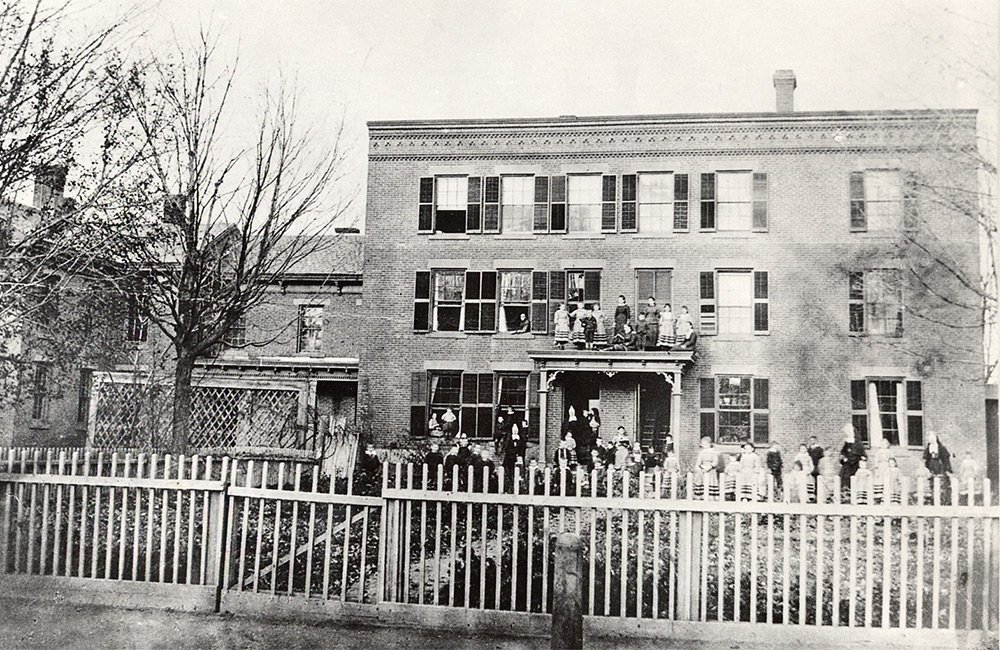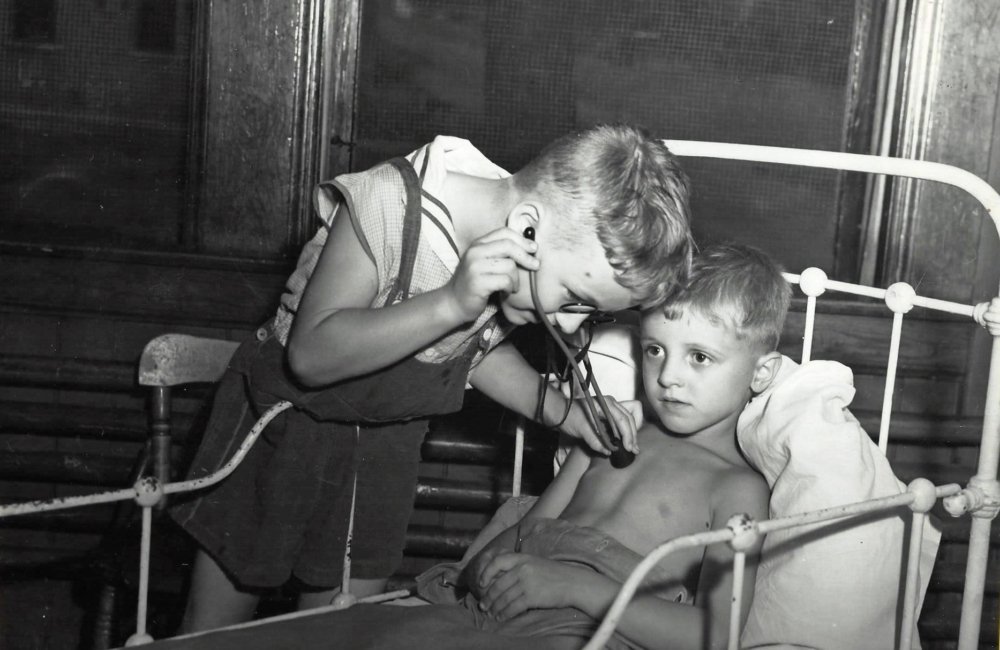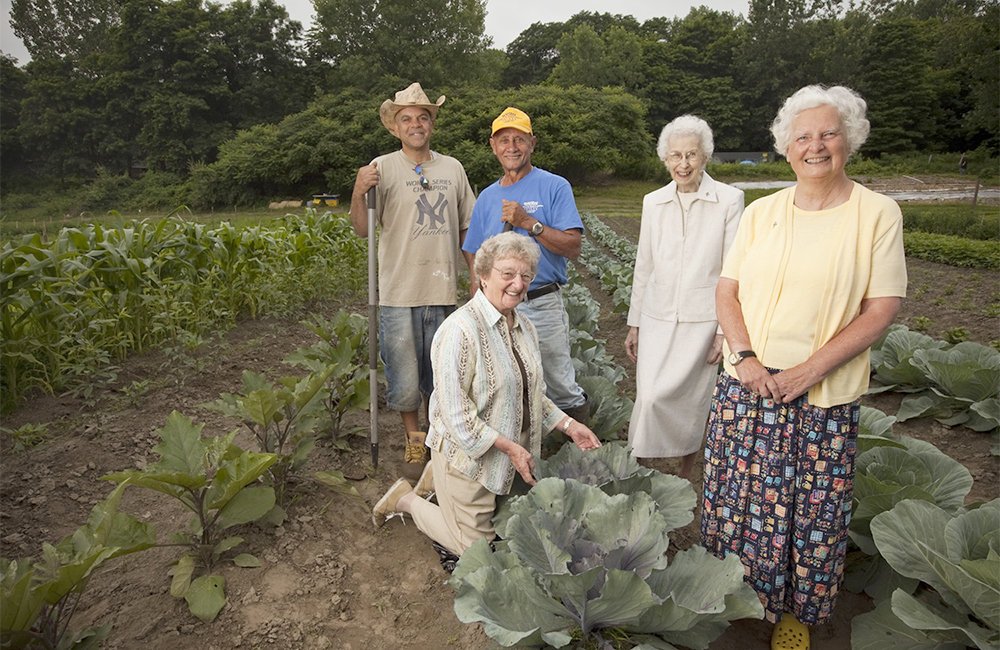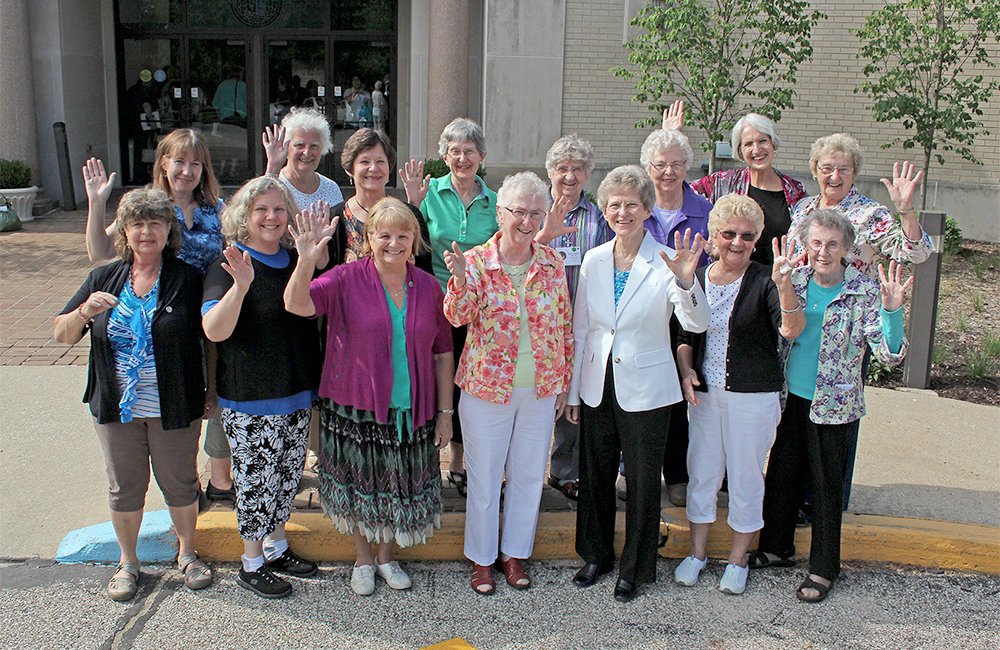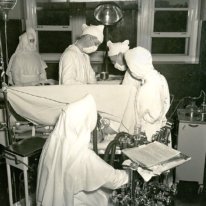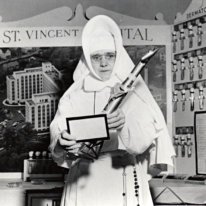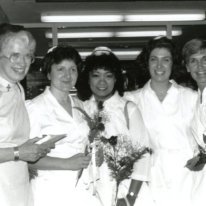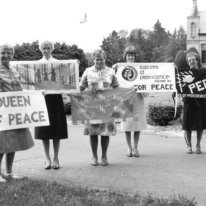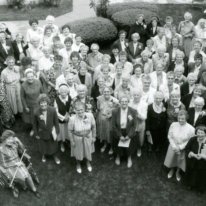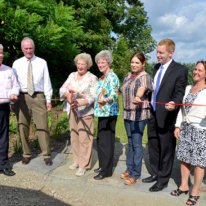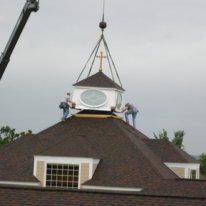Over 146 years of stories, headlines and photos
Our first pioneers, the Sisters of Charity of the House of Providence, arrived in Holyoke in November 1873 from their Motherhouse in Kingston, Ontario, Canada. They were responding to a request from the Reverend Patrick Harkins, pastor of St. Jerome’s Church, to address the charitable needs of the City’s poor immigrant population, particularly the young Irish and Scottish girls working in the mills.
Over the next 19 years, these Sisters labored under very difficult circumstances ministering to the sick and dying, caring for the orphaned and elderly, and teaching boys in St. Jerome’s Institute. They admitted their first patient to their “House of Providence” on December 2, 1873 and with that admission established a ministry that would come to be known as Providence Hospital—the first Catholic Hospital in Western Massachusetts.
Our story begins

Sister Mary of Providence (Catherine Horan) was 26 in 1875 when she came to teach the boys at Saint Jerome’s Institute.
In September 1873 two Sisters of Charity of the House of Providence from Kingston, Ontario, Canada came to St. Jerome’s Church in Holyoke, Massachusetts. Once there, they asked pastor Father Patrick Harkin’s permission to solicit funds from his parishioners for their ministries back home. He agreed on the condition that once they returned to Canada, they ask their superiors to send Sisters to open a mission in his city.
His proposal was accepted and four Sisters returned to Holyoke for that purpose on November 7, 1873. Within a week, they were caring for their first orphan and on December 2 of that year they admitted their first hospital patient.
The orphans and patients in their care quickly grew in number. And, when they were not tending to those in their House of Providence, they were making home visits to the poor, nursing them in their homes, spending nights with the dying, or preparing the dead for burial.
Two years later, Father Harkins asked the Sisters to teach in the parish’s boys school. Though not a work for which their community was founded, they agreed, and four more Sisters arrived to take up the task. Sister Mary of Providence (Catherine Horan), who in time would be called Mother Mary of Providence, the foundress of our community, was among them.
When the newer arrivals were free from school responsibilities, they helped the other Sisters with their never-ending work with orphans, the aged and the infirm. They even relieved their counterparts for night duty, whether at the House of Providence or elsewhere—for nursing through the night, praying with the dying, comforting the grieving, burying the dead, were all their works, too.
Click on the images below to view larger.
- Father Patrick Harkins, first pastor of St. Jerome’s Parish.
- The first Holyoke House of Providence, circa 1875.
- Saint Jerome’s Institute where the Sisters taught boys.
A historic petition
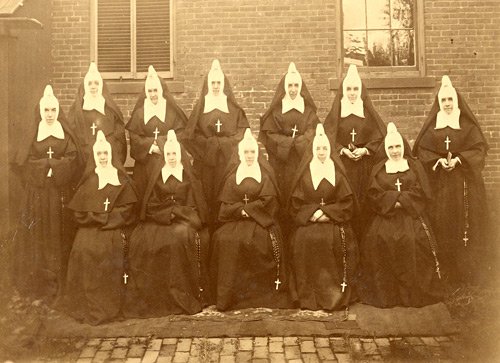
Pioneer Sisters in the 1870s.
In 1892, the Bishop of the Springfield Diocese, of which Holyoke is a part, petitioned Rome to establish in Holyoke, Massachusetts, an independent diocesan congregation of women religious, the Sisters of Providence, separate from the Kingston congregation. This put Sister Mary of Providence in the untenable position of receiving an order from her Superior General in Kingston, Ontario, to have the Sisters return home to Canada and an Edict of Status Quo from the Vatican (under threat of ex-communication) to remain in place until a decision was made in Rome. Sister Mary of Providence remained in place until the Bishop of Springfield learned that his petition had been approved in Rome. The Sisters who were missioned in Holyoke had the option of returning to their Motherhouse in Canada or remaining as members of our new community—the Sisters of Providence, Holyoke. This was a very painful process for all of the Sisters.
Thirty of these pioneer women religious, including Sister Mary of Providence (seated, third from left), felt a call from Providence to remain in Holyoke. Others heard a different Providence call and returned to Kingston.
The 30 remaining Sisters became the nucleus of our new community and on August 17, 1892 a provisional government was established with Sister Mary of Providence—now Mother Mary of Providence—principal of St. Jerome’s School, as our first major superior. On October 18 of that same year, the members of the new community wore, for the first time, the headdress, or garniture, they had adopted following their separation from the Kingston community.
The next years for the Sisters remaining in Holyoke were as grueling and rewarding as the years that preceded them, yet under the leadership of our Mother Mary of Providence, the Sisters opened 20 works of charity and made sharp inroads into alleviating the healthcare and social needs of poor and marginalized people in both western and central Massachusetts.
Their ministries included several hospitals, schools of nursing, an orphanage, nursing homes, residences for working girls, homes for unwed mothers and day nurseries. Among them were our House of Mercy (today Mercy Medical Center) and St. Luke’s Home, both in Springfield; Farren Memorial Hospital (today Farren Care Center) in Montague City; Providence Hospital, Beaven Kelly Home, Holy Family Institute at Brightside, an orphanage for boys, and Mount Saint Vincent, an orphanage for girls, all in Holyoke; St. Vincent Hospital in Worcester; and St. Luke’s Hospital in Pittsfield.
In 1932, after nearly 60 years of living in Holyoke without an adequate home, the Sisters were blessed to move in to a brand- new Providence Mother House. From the first pioneer Sisters in 1873 until then, they had not had a central home that could accommodate them, an Infirmary, or adequate offices for their Administration. Each time the Sisters had saved enough money to begin its construction, some other urgent need in one of their ministries took precedence.

Click on the images below to view larger.
- Original Mercy Hospital in Springfield circa 1927.
- The Sisters’ small charges in front of Mount Saint Vincent.
- A Sister of Providence instructing her young charges in song.
- Providence Hospital on Dwight Street in Holyoke.
Rebuilding, expanding, modernizing
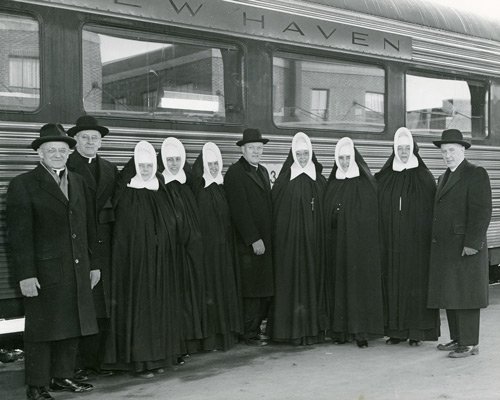
Five Sisters of Providence made history when they departed Springfield’s Union Station for North Carolina in 1956.
Later the Sisters rebuilt many of their institutions since some were more than 50 years old and others needed expansion or modernization.
And, at the same time, they worked on obtaining the advanced educations needed for the leadership roles their modernized, sophisticated health and human service ministries were going to demand.
In the 1950s, the Sisters became pioneers in much the same way as did the first Kingston Sisters when they opened a small, rural hospital in Murphy, North Carolina.
As the years unfolded, the Sisters founded other ministries in the state of North Carolina including at St. Joseph of the Pines Hospital in Southern Pines. Today that ministry is St. Joseph of the Pines Health System with a focus on continuing care retirement communities and home and community-based services.
Click on the images below to view larger.
- 1951 ground breaking for new St. Vincent Hospital.
- Sisters in operating room at Mercy Hospital.
- A Sister of Providence embraces her young friend.
Responding to changes
When in the 1960s Vatican II called for the renewal of religious life, the Sisters of Providence took that call seriously. They were ready to let go of their traditional and more ordered way of life to attend to the changing needs of a contemporary society. Gradually they adapted their traditional ministries and embraced new works.
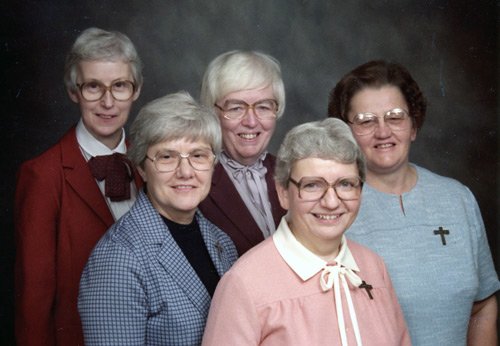
Post Vatican II these five Sisters of Providence were among the first to live in one of the Congregation’s “local communities” rather than at their places of ministry.
By the 1970s, the changes brought to their religious lives by the decrees of Vatican II were realities and they were reflecting upon and reevaluating their sense of identity as women religious and as a community. In Chapter meetings, they worked to revitalize, and then to articulate, their new understanding of their founding charism and mission. They captured their reinterpretations in an interim document titled Signs of Hope: Our Way of Life, which attempted to express the community’s evolving understanding of itself, the Church, and society.
The Sisters of Providence were now witnessing to Christ in ever-increasing numbers outside our institutions and in such diverse activities as drug programs, a Spanish apostolate, working with emotionally and developmentally disabled children, visiting the aged in their homes and in nursing homes, visiting prisoners in rehabilitation centers, assisting the visually impaired, participating in youth programs in detention centers and summer programs, teaching at community colleges, contributing to state and civic commissions, doing catechetical work, and being involved in the Newman Center apostolate.
Their institutions underwent changes, too. Among them, a new wing was added at Farren Memorial Hospital (today Farren Care Center) in Montague City, and St. Luke’s Hospital merged with Pittsfield General Hospital to become Berkshire Medical Center in Pittsfield.
The Sisters of Providence are credited with beginning the first Methadone Maintenance Treatment Program at Providence Hospital in the first year of this decade. In addition, these years saw them opening Mount Saint Vincent Nursing Home a short distance from our Providence Mother House in Holyoke, and building a new Mercy Hospital (now Mercy Medical Center) and an adjoining physicians’ office building in Springfield. In Westfield, they founded Genesis Spiritual Life Center on property formerly used first as a novitiate and then as the Guild of the Holy Child for unwed mothers.
Click on the images below to view larger.
- Sister Mary Dolorum, mycologist and lab technologist.
- Sisters take up shovels at Mount St. Vincent wing ground breaking.
- Sister Ninfa Arellano during her Spanish Apostolate ministry.
Consolidating institutions and ministries
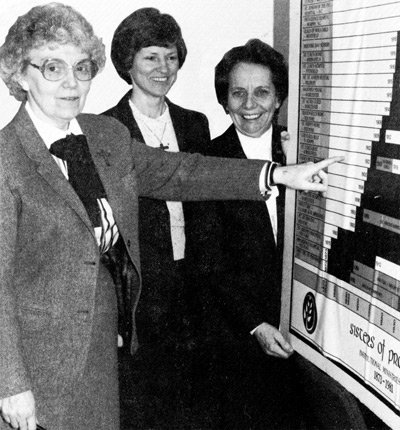
Sisters announce the formation of the Sisters of Providence Health System.
By 1980, such global issues as hunger, poverty, discrimination, pollution and the potential for nuclear holocaust prompted us to focus on issues of social justice and to discern how our charism and call “to reveal the mystery of Providence” could affect the modern world. Empowered by the women’s movement, and in a spirit of collegiality, they worked together over a period of three years to write the Community’s present Constitution which articulated their renewed sense of charism and mission “to communicate hope to those in need through ministries of healing.” The 1981 Chapter, which ratified the Constitution, also called for corporate restructuring in order to assure the continuance of the charism in Providence-sponsored institutions through collaboration with the laity.
In response, they brought the health care facilities they owned and operated together in 1984 to form Sisters of Providence Health and Human Service System, Inc. (SPHS). These facilities initially included Providence Hospital, Beaven Kelly Home, and Mount St. Vincent Nursing Home, all in Holyoke; Mercy Hospital and St. Luke’s Home, in Springfield; Our Lady of Providence Children’s Center in West Springfield; Farren Memorial Hospital in Montague City; and St. Joseph of the Pines in Southern Pines, North Carolina. St. Vincent Hospital in Worcester did not join as part of SPHS.
At the same time, another milestone occurred in the 1980s when the Sisters of Providence welcomed the Community’s Charter Class of Associates, lay women and men who resonate with our charism and desire to share in our spirituality and mission.
Click on the images below to view larger.
- Sister Mary Caritas’ healthcare roles brought her to D.C.
- The Charter Class of Associates (1982).
- Sister Barbara Burke in parish ministry (1986).
- Sisters hold banners promoting global peace.
Reaching milestones

Sister Theresa Lucier holds the SP Time Capsule prior to its burial during the 1993 Chapter’s Ritual of History.
In the 1990s the Sisters continued to foster a contemplative attitude toward life and to integrate their spirituality into all they were doing. Knowing that a contemplative attitude is a call for all believers, they continued to promote spiritual leadership and to share our charism and spirituality with all with whom they lived and worked.
Sisters of Providence Health and Human Service System, Inc. (DBA Providence Systems) changed its name to Sisters of Providence Health System, Inc. (SPHS). Six years later the Sisters were instrumental in joining with two other Catholic health systems—namely, Eastern Mercy Health System and Allegany Health System—to form Catholic Health East, one of the larger Catholic health systems in the U.S., a multi-institutional system with facilities spanning the eastern coast from Maine to Florida.
By 1992, 100 years from the 1892 founding as an independent community in the Diocese of Springfield, over 700 women had become Sisters of Providence. They celebrated this milestone with a Centennial Year observance that included assembling a time capsule that they later buried on the Mother House property. Items preserved in the time capsule included their Constitution, a Providence cross and Associate pin, mementos of the Centennial Year celebrations, and copies of the congregation’s quarterly newsletter, Tracings.
At the 1993 Chapter, the Sisters drafted the community’s Directional Statements that urge them to make all their decisions “in light of their impact on women, earth, and those who are poor.” They reaffirmed their commitment to those directives during the six Chapters that followed—up to and including the most recent Chapter in 2019.
It was during the 1990s, too, that the Sisters found the Mother House was now too large for their needs. Wanting to be good stewards of such a wonderful resource and knowing of the need in the area for moderate elder housing, they transformed the building into Providence Place at Ingleside, an independent living community with 119 units for those over age 55.
Click on the images below to view larger.
- The SPHS Executive Team in Corporate Office.
- Centennial gift from Canadian Sisters of Providence.
- Centennial Reception in Mother House cloister garden.
- Sisters process into Mother House chapel at Chapter 1993.
- Associates attended Chapter liturgies and socials.
Entering the new millennium

View of a section of the Wall of Remembrance at Mercy Medical Center in Springfield.
Now, in the 21st Century, as in the 146 years of the Sisters of Providence history that preceded it, the Sisters continue to watch the signs of the times as they seek to identify and respond to the needs of the day. Since the year 2000, they have opened Mary’s Meadow at Providence Place (a 40-bed, small house concept skilled nursing and rehabilitation facility), established The Hillside at Providence campus dedicated to programs and services for elders, and opened Hillside Residence, a 36-unit affordable elder housing facility linked with a PACE program (Program for All-Inclusive Care For Elders). Catholic Health East, of which the Sisters of Providence Health System was a founding member, merged with Trinity Health, one of the largest Catholic Health Systems in the U.S. Locally, the Sisters created the Sisters of Providence Ministry Corporation (SPMC) as a holding company for their remaining ministries and properties, including Providence Place, Mary’s Meadow, Genesis Spiritual Life and Conference Center, Providence Ministries for the Needy, and eventually The Hillside at Providence and Hillside Residence.
Conscious of their responsibility to care for the earth, the Sisters placed 26 acres of their agriculturally rich property along the Connecticut River in Holyoke into a land trust with The Trustees of Reservations. This action ensures the property, named Land of Providence, will be protected in perpetuity from commercial development. And, a few years later, the Sisters opened Providence Arboretum on their 19 acres of property at Genesis Spiritual Life and Conference Center in Westfield.
The Sisters observed two significant milestone anniversaries in this time period, too. The first, in 2012, recalled the 1892 founding as the Sisters of Providence, an independent congregation in the Diocese of Springfield. The second, the 2013 Anniversary, celebrated the arrival in Holyoke of the pioneer Sisters from Kingston, Ontario, Canada. To mark these events, they commissioned a history book, titled 140 Years of Providential Caring. In it, the writers explored the impact the Sisters and their ministries have had over years on the people of Western Massachusetts and beyond. Earlier they published another of their histories titled Seeds of Hope—A History of the Sisters of Providence, and released a historical video documentary “Spirit of Providence.”
Another representation of their history is the Wall of Remembrance available for viewing at Mercy Medical Center in Springfield.
Now as the journey continues in this, the Third Millennium, the Sisters of Providence, as the Sisters of the past, face the unknown future with undaunted hope and deep trust in a Provident God. For, in the words of their Foundress Mother Mary of Providence, “No trials of the future should dismay those who know the past.”
- Ribbon Cutting at Land of Providence.
- Construction workers place cupola on peak of Mary’s Meadow chapel.
- Mary’s Meadow at Providence Place opened in 2009.
- The Sisters’ history book, “140 Years of Providential Caring.”
- The SP Community’s Anniversary Liturgy in 2012.
- SPs honored as Difference Makers by Business West (2013).
- Aerial view of Mary’s Meadow with Hillside Residence upper left.

No trials of the future should dismay those who know the past.
–Mother Mary of Providence, SP Foundress
